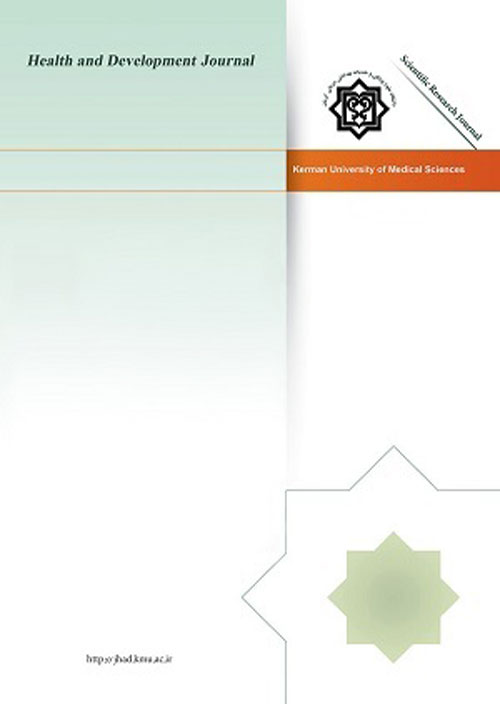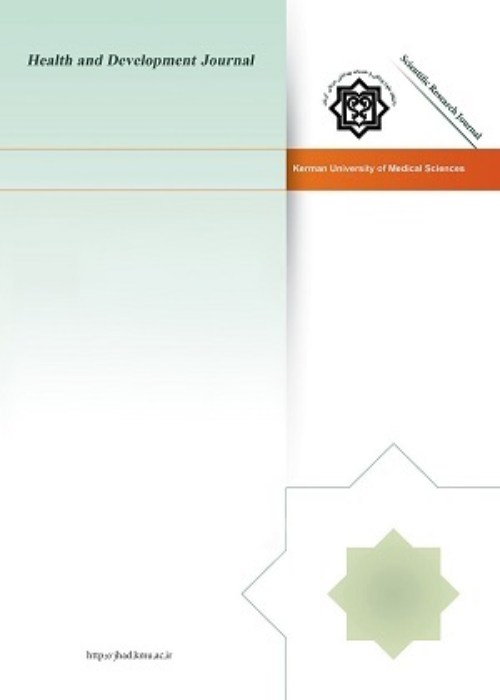فهرست مطالب

Health and Development Journal
Volume:10 Issue: 4, Autumn 2021
- تاریخ انتشار: 1401/08/18
- تعداد عناوین: 8
-
-
Pages 215-220BackgroundMicrobial contamination of water sources in dental units is one of the problems in dentistry as such contamination can lead to the occurrence of dangerous infections. Given the importance of infection control and creating a healthy environment for the treatment of patients, this study conducted a microbiological analysis of water in the dental units of Sari School of Dentistry in 2019.MethodsIn this descriptive-analytical and cross-sectional study, three units from each of the endodontic, restorative, surgical, pediatric, and prosthetic units of Sari School of Dentistry were randomly selected. Samples of 3-way syringe water, turbine water before and after flushing, and glass water were prepared and transferred to the microbiology department in sterile tubes. The samples were then cultured in Müller Hinton agar and blood agar and placed in an incubator at 37 °C for 24 hours. After incubation, gram staining was performed on the samples in which the bacterial colony had grown. The bacteria were examined for morphology and gram reaction.ResultsOut of 61 samples, 23 samples (37.7%) were infected with bacterial colonies. The highest frequency of bacterial infection was found in the mixed bacterial group (gram-positive cocci and gram-positive bacilli). The results of the chi-square test and Fisher's exact test showed no significant relation between the sampling site and contamination (P = 0.309).ConclusionWater contamination in the pediatric and endodontic units in Sari School of Dentistry is high. Thus, effective measures should be taken to reduce water pollution in these units and reduce the risk of infection in staff and patients.Keywords: Dental unit, Dental unit waterline, Biofilm, Dental infection control
-
Pages 221-230Background
Currently, various organizations are interested in analyzing the psychological resilience of their employees and the factors affecting it. Extensive studies have not yet addressed psychological resilience among bank employees. To this end, this study investigated resilience and the factors affecting employees of the branches of Bank Melli in Kerman.
MethodsIn this self-reported cross-sectional survey, 358 employees in the branches of Bank Melli in Kerman were selected as the respondents using stratified random sampling. The respondents completed a questionnaire adapted from the Connor-Davidson Resilience Scale (CD-RISC), the Persian version of the Emotional Intelligence Scale-41 (FEIS-41), Multidimensional Scale of Perceived Social Support (MSPSS), and Occupational Stress Questionnaire-HSE of the British Institute of Health and Safety from August to December 2019. The collected data were analyzed using SPSS 23 software and AMOS 21 software using structural equation modeling and bootstrap method to evaluate the mediating effect.
ResultsEmotional intelligence and social support scores were both directly (β = 0.485 and p˂0.001 for emotional intelligence, and β = 0.248 and p˂0.001 for social support, respectively) and indirectly (β = 0.174 and p = 0.001 for emotional intelligence, and β = 0.081 and p = 0.001 for social support) associated with the resilience scores. The three variables of emotional intelligence, social support, and work-related stress predicted 51% of the variances of resilience.
ConclusionThe findings showed that emotional intelligence and social support can increase the psychological resilience of bank employees by affecting their work-related stress
Keywords: Resilience, Work-related stress, Emotional Intelligence, Social support, Bank employees -
Pages 231-241BackgroundThis study aimed to investigate the factors affecting cardiovascular disease risk assessment (CVDRA) in middle-aged women in Kerman based on the health belief model, in 2019.MethodsThis cross-sectional study was conducted on 400 middle-aged women in Kerman. The women were selected using multi-stage random sampling. The data in this study were collected using a researcher-made questionnaire developed based on the constructs of the health belief model. Moreover, the risk assessment data were extracted from the ministry of health, Integrated Health System (SIB System). The collected data were analyzed using SPSS software (version 20).ResultsThe mean age of the participants was 38.32±6.76 years. Most of the participants were married (87.8%) and 40% of them had a university education. Besides, 78% of middle-aged women had performed cardiovascular disease risk assessment (CVDRA). The results of the logistic regression analysis indicated the construct of perceived benefits was the main predictor of cardiovascular disease risk assessment in women (Odds ratio=1.02; P= 0.012). But, the other constructs of the health belief model were not significantly associated with cardiovascular disease risk assessment behavior in middle-aged women (P˃0.05).ConclusionGiven that the construct of perceived benefits is the strongest predictor of cardiovascular disease risk assessment behavior in middle-aged women, health promotion interventions need to be planned and performed for cardiovascular disease risk assessment in middle-aged women with an emphasis on its perceived benefits.Keywords: risk assessment, Cardiovascular disease, middle-aged women, Health Belief Model
-
Pages 242-248BackgroundSafe childbirth is a health concern among refugees. This study was conducted to determine factors which influence safe delivery among Pregnant Afghan Refugees (PAR) based on the Health Promotion Model (HPM).MethodsThis descriptive and analytical cross-sectional study included 160 pregnant Afghan refugees living in Sirjan, a city in Kerman, Iran. The data were collected using a 45-item questionnaire in three parts (demographic information, constructs of Pender’s HPM, and safe childbirth behavior questions). After data collection, all data were analyzed by SPSS19, through descriptive statistics and linear regression.ResultsHealth promotion model constructs (perceived self-efficacy, perceived barriers, perceived benefits, perceived social support, and interpersonal norms) had direct and significant effects on promoting safe childbirth behavior (P<0.05), and perceived social support was the most influential factor.ConclusionStrengthening health-promoting behaviors including perceived social support, perceived self-efficacy, perceived barriers, interpersonal norms, and perceived benefits can help improve safe delivery among Pregnant Afghan Refugees (PARs) in Iran.Keywords: health promotion, Behavior, Pregnant, Refugees
-
Pages 249-254Introduction
Addiction is one of the most important health challenges around the world. Investigating effective prevention methods and treatment interventions are the main concerns of researchers in this field. The present study was done to evaluate the quality of non-drug interventions at addiction treatment centers in Yazd province.
MethodOut of 130 addiction treatment centers in Yazd Province, 30 centers, and from these centers 300 patients were selected randomly. Information was acquired through questionnaires, validated by the researcher. The assessments were focused on different fields of non-drug intervention at addiction treatment centers including individual consultation, motivational interviews, training about how to cope with cravings, and group therapy.
ResultsThe quality of non-drug interventions at 86.7% of the centers was relatively moderate and in 10% was poor. 30% and 33.3% of the centers had respectively poor and moderate quality services for motivational interviews. The quality of training services with respect to coping with craving was medium at 50% and desirable at 50% of the centers. Moreover, 40% and 53.3% of the centers had a poor and moderate quality level of group therapy respectively. Patient satisfaction about non-drug interventions was mainly high or very high.
ConclusionIn non-drug interventions, patient’s satisfaction was high. Therefore, it is suggested that non-drug temptation reduction interventions be performed in rehabilitation centers, along with other treatments.
Keywords: Satisfaction, Non-drug interventions, Addiction treatment -
Pages 255-261Background
Depression is one of the common problems during pregnancy that can have adverse effects on the fetus and mother and even after delivery can adversely affect the baby and mother. To this end, this study aimed to determine the frequency of depression and its related factors in women in the third trimester of pregnancy visiting the health centers affiliated with the Kerman University of Medical Sciences.
MethodsThis descriptive-analytical cross-sectional study was conducted in 2017 in health centers affiliated with the Kerman University of Medical Sciences. The participants were pregnant women in the third trimester of pregnancy who were selected using convenience sampling. The data in this study were collected using the Edinburgh Postnatal Depression Scale (EPDS). The collected data were analyzed with SPSS software (version 22).
ResultsThe frequency of depression in women in the third trimester of pregnancy was 12.7%. The frequency of depression was higher in the age group of over 30 years, the age of the spouse under 30 years, the age at the time of marriage over 20 years, housewives, the first pregnancy, and in planned pregnancy. Multivariate logistic regression analysis showed that the young age of the spouse was associated with a significant increase in depression during pregnancy (adjusted OR = 13.72, 95% CI: 2.60-27.72, P-value = 0.002).
ConclusionGiven the relatively high prevalence of depression in pregnant women in the third trimester, screening and identification of these women are very important. Furthermore, organizing training courses on depression for women and their husbands and effective behavioral and treatment solutions should be considered one of the priorities of health centers.
-
Pages 262-270Background
Employee health is one of the important factors in organizational success, and the lack of coordinated use of ergonomic principles and the safety climate in designing suitable work systems in organizations can increase the risk of occupational and work-related injuries. This study aimed to investigate the relation between safety climate and the prevalence of musculoskeletal disorders (MSDs) among employees in manufacturing companies in Urmia County.
MethodsThe participants were 359 employees working in manufacturing companies. The data were collected using the Safety Climate Scale and the Nordic Musculoskeletal Questionnaire. The collected data were analyzed using descriptive statistics, t-test, ANOVA, and the chi-square test.
ResultsIn the present study, the most and least frequent MSDs were reported by the participants in the neck and elbow, respectively. Safety management methods obtained the highest score (3.88±0.71) and employee participation and training obtained the lowest score (3.42±0.81). The findings also showed that the participants who gained a higher safety climate score reported a lower prevalence of MSDs in the neck, hand, wrist, upper and lower back areas, and one or both thighs.
ConclusionSafety climate is one of the important factors affecting the prevalence of MSDs. Thus, managers of manufacturing companies should constantly try to improve the safety climate in the workplace to contribute to reducing occupational injuries, especially MSDs.
Keywords: Safety climate, Musculoskeletal disorders, Implementation methods, participation, Training -
Pages 271-278Background
Substance dependence is a maladaptive pattern that leads to clinically significant degradation and is manifested through a set of cognitive, behavioral, and physiological symptoms. The aim of this study was to evaluate the effectiveness of cognitive behavioral therapy (CBT) on alexithymia, emotional regulation and psychological capital of male substance abusers, under the auspices of addiction treatment centers.
MethodsThis randomized clinical trial was conducted from June to September 2021 in Kerman, Iran using a pretest, post-test design with a control group. A single therapy center was randomly selected via multi-stage cluster sampling from several substance abuse treatment centers using agonists for treatment. Then 50 people were randomly selected and allocated to experimental and control groups. The research instruments were questionnaires for alexithymia, emotional regulation, and psychological capital. After the pretest phase, the experimental group underwent 10 sessions of CBT. In the next step, the post-test was conducted and after 6 weeks the follow-up test was performed on the groups. The control group did not receive the intervention. Finally, the data obtained from 40 participants were analyzed using the t-test in SPSS-25 software.
ResultsThe findings indicated that the intervention in the post-test phase significantly reduced alexithymia (P=0.001), increased emotion regulation (P=0.001) and increased psychological capital (P=0.003). Also, in the follow-up phase, the results show a significant decrease in alexithymia (P=0.002), increase in emotion regulation (P=0.001) and increase in psychological capital (P=0.002).
ConclusionCBT can improve alexithymia, emotional regulation and psychological capital of substance abusers and can be used in addiction treatment centers.
Keywords: Addiction, Cognitive behavior therapy, Alexithymia, Emotion regulation, Psychological capital


